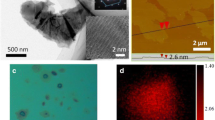Abstract
In pursuing excellent supercapacitor electrodes, we designed a series of MoS2/CoS2 composites consisting of flower-liked MoS2 and octahedron-shaped CoS2 through a facile one-step hydrothermal method and investigated the electrochemical performance of the samples with various hydrothermal time. Due to the coupling of two metal species and a big amount of well-developed CoS2 and MoS2, the results indicated that the MoS2/CoS2 composites electrodes exhibited the best electrochemical performance with a large specific capacitance of 490 F/g at 2 mV/s or 400 F/g at 10 A/g among all samples as the hydrothermal time reached 48 h (MCS48). Furthermore, the retention of MCS48 is 93.1% after 10000 cycles at 10 A/g, which manifests the excellent cycling stability. The outstanding electrochemical performance of MCS48 indicates that it could be a very promising and novel energy storage material for supercapacitors in the future.
Similar content being viewed by others
References
Ren X C, Tian C J, Li S, et al. Facile synthesis of tremella-like MnO2 and its application as supercapacitor electrodes. Frontiers of Materials Science, 2015, 9(3): 234–240
Zhao Y C, Misch J, Wang C A. Facile synthesis and characterization of MnO2 nanomaterials as supercapacitor electrode materials. Journal of Materials Science: Materials in Electronics, 2016, 27(6): 5533–5542
Gao Y P, Wang L B, Li Z Y, et al. Electrochemical performance of Ti3C2 supercapacitors in KOH electrolyte. Journal of Advanced Ceramics, 2015, 4(2): 130–134
Bissett M A, Kinloch I A, Dryfe R A W. Characterization of MoS2-graphene composites for high-performance coin cell supercapacitors. ACS Applied Materials & Interfaces, 2015, 7(31): 17388–17398
Zhang L J, Hui K N, Hui K S, et al. Facile synthesis of porous CoAl-layered double hydroxide/graphene composite with enhanced capacitive performance for supercapacitors. Electrochimica Acta, 2015, 186(6): 522–529
Zhang L, Hui K N, Hui K S, et al. High-performance hybrid supercapacitor with 3D hierarchical porous flower-like layered double hydroxide grown on nickel foam as binder-free electrode. Journal of Power Sources, 2016, 318: 76–85
Jaramillo T F, Jørgensen K P, Bonde J, et al. Identification of active edge sites for electrochemical H2 evolution from MoS2 nanocatalysts. Science, 2007, 317(5834): 100–102
Li Y, Wang H, Xie L, et al. MoS2 nanoparticles grown on graphene: an advanced catalyst for the hydrogen evolution reaction. Journal of the American Chemical Society, 2011, 133(19): 7296–7299
Bissett M A, Kinloch I A, Dryfe R A. Characterization of MoS2–graphene composites for high-performance coin cell supercapacitors. ACS Applied Materials & Interfaces, 2015, 7(31): 17388–17398
Zhou X, Xu B, Lin Z, et al. Hydrothermal synthesis of flower-like MoS2 nanospheres for electrochemical supercapacitors. Journal of Nanoscience and Nanotechnology, 2014, 14(9): 7250–7254
Chen J, Li S L, Xu Q, et al. Synthesis of open-ended MoS2 nanotubes and the application as the catalyst of methanation. Chemical Communications, 2002, 16(16): 1722–1723
Ji Y, Liu X Y, Liu W, et al. A facile template-free approach for the solid-phase synthesis of CoS2 nanocrystals and their enhanced storage energy in supercapacitors. RSC Advances, 2014, 4(91): 50220–50225
Wan H, Ji X, Jiang J, et al. Hydrothermal synthesis of cobalt sulfide nanotubes: The size control and its application in supercapacitors. Journal of Power Sources, 2013, 243(6): 396–402
Chakraborty I, Malik P K, Moulik S P. Preparation and characterisation of CoS2 nanomaterial in aqueous cationic surfactant medium of cetyltrimethylammonium bromide (CTAB). Journal of Nanoparticle Research, 2006, 8(6): 889–897
Ding S J, Jiang S J, Zhou Y S, et al. Catalytic characteristics of active corner sites in CoMoS nanostructure hydrodesulfurization–A mechanism study based on DFT calculations. Journal of Catalysis, 2017, 345: 24–38
Lauritsen J V, Besenbacher F. Atom-resolved scanning tunneling microscopy investigations of molecular adsorption on MoS2 and CoMoS hydrodesulfurization catalysts. Journal of Catalysis, 2015, 328: 49–58
Xiao J, Wan L, Yang S, et al. Design hierarchical electrodes with highly conductive NiCo2S4 nanotube arrays grown on carbon fiber paper for high-performance pseudocapacitors. Nano Letters, 2014, 14(2): 831–838
Chen H, Jiang J, Zhang L, et al. Highly conductive NiCo2S4 urchin-like nanostructures for high-rate pseudocapacitors. Nanoscale, 2013, 5(19): 8879–8883
Xiao J, Yang S. Sequential crystallization of sea urchin-like bimetallic (Ni, Co) carbonate hydroxide and its morphology conserved conversion to porous NiCo2O4 spinel for pseudocapa-citors. RSC Advances, 2011, 1(4): 588–595
Lu X, Pellechia P J, Flora J R V, et al. Influence of reaction time and temperature on product formation and characteristics associated with the hydrothermal carbonization of cellulose. Bioresource Technology, 2013, 138: 180–190
Li H Y, Zhao Y C, Wang C A. Formation of molybdenum–cobalt sulfide by one-step hydrothermal reaction for high-performance supercapacitors. Journal of Materials Science: Materials in Electronics, 2018, 29(16): 13703–13708
Tao F, Zhao Y Q, Zhang G Q, et al. Electrochemical characterization on cobalt sulfide for electrochemical supercapacitors. Electrochemistry Communications, 2007, 9(6): 1282–1287
Ragupathy P, Vasan H N, Munichandraiah N. Synthesis and characterization of nano-MnO2 for electrochemical supercapacitor studies. Journal of the Electrochemical Society, 2008, 155(1): A34–A40
Chmiola J, Yushin G, Dash R, et al. Effect of pore size and surface area of carbide derived carbons on specific capacitance. Journal of Power Sources, 2006, 158(1): 765–772
Acknowledgements
This work was supported by the National Natural Science Foundation of China (Grant No. 51572145).
Author information
Authors and Affiliations
Corresponding author
Rights and permissions
About this article
Cite this article
Li, H., Zhao, Y. & Wang, CA. MoS2/CoS2 composites composed of CoS2 octahedrons and MoS2 nano-flowers for supercapacitor electrode materials. Front. Mater. Sci. 12, 354–360 (2018). https://doi.org/10.1007/s11706-018-0437-9
Received:
Accepted:
Published:
Issue Date:
DOI: https://doi.org/10.1007/s11706-018-0437-9




